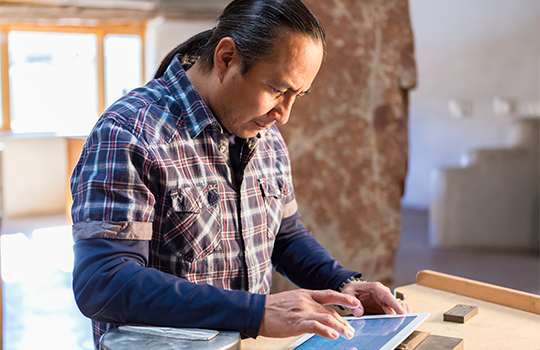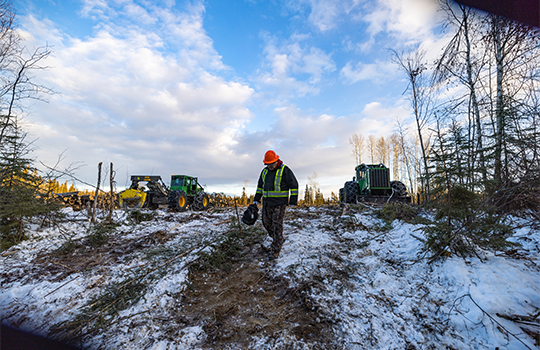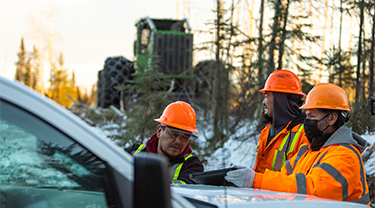In Canada, there are more than 50,000 Indigenous-owned companies. Comprised of three groups—First Nations, Métis and Inuit—this dynamic and robust business community contributes $48.9 billion annually to Canada’s economy (Census Canada, 2020).
According to the Indigenomics Institute, that number could surge to $100 billion if governments and corporations embrace more inclusive policies and business practices to engage with Indigenous companies.
Indigenous peoples (our nation’s fastest-growing demographic) are also a major employer of non-Indigenous peoples, providing jobs across Canada.
A prosperous, healthy future for Canada depends on the full and equal participation of everyone.
“Growing the Indigenous economy, in turn, grows the Canadian economy,” says Todd Evans, national lead, Inclusive Trade, Indigenous exporters at Export Development Canada (EDC). “A prosperous, healthy future for Canada depends on the full and equal participation of everyone.”
By the numbers
50,000+ Number of Indigenous-owned companies in Canada
$50B Indigenous contribution to the Canadian economy
1.4% Canadian SMEs are majority owned by Indigenous business owners
65% Indigenous business owners rely on personal savings to start a new business
19% Indigenous business owners rely on bank loans and credit to start a new business
Geared up for global trade
Today, Indigenous entrepreneurs and communities are looking to international trade to help expand their businesses and achieve financial sovereignty.
It comes naturally, Evans points out, as Indigenous nations have been traders since long before the arrival of the first European settlers.
Indigenous entrepreneurs put their culture and values central to their company, building a strong business brand that stands out on the global market.
“Trade flourished across all of North America and this natural, entrepreneurial spirit still exists today,” he says. The majority of Indigenous businesses are small, often due to barriers in scaling up, or because they’re new.
“Indigenous entrepreneurship is flourishing, especially among youth,” says Evans. “Indigenous entrepreneurs put their culture and values central to their company, building a strong business brand that stands out on the global market.”
There are significant opportunities at home and abroad for Indigenous businesses, which are spread across all sectors—from traditional mining, resources and seafood to advanced technology services, hospitality and health and beauty products. Many export to global markets directly, while a significant proportion are indirect exporters, supplying other companies with materials for their exported products.

Key challenges to overcome
To realize the full economic, social, environmental and other benefits of a thriving Indigenous business community, there are challenges to overcome.
“This is already an economically disadvantaged business community,” Evans says, “Indigenous companies also have unique challenges that hinder growth and make it difficult to sell their goods and services in international markets.”
1. Lack of access to working capital. This is the No. 1 issue for most Indigenous businesses for many reasons:
- Many don’t have a relationship with traditional banks—something that EDC is actively working to facilitate with introductions between financial institutions (FIs) and Indigenous companies as part of our Indigenous business plan.
- They often face institutional bias because historically, they’re seen as higher risk—loan approval rates stand at about 90% for Canadian companies, but drop to 58% for Indigenous businesses.
- They often don’t have the collateral needed to get loans and operating lines of credit.
- Even if they have assets, using them to secure a loan isn’t often an option for Indigenous entrepreneurs living on reserves due to restrictions under the Indian Act.
2. The remoteness of communities. Be it Northern Ontario, Nunavut, Labrador or the Northwest Territories, remote locations can create problems, including:
- Shipping goods. This is logistically difficult if there aren’t roads, highways or airports nearby.
- Staying connected. A lack of reliable internet service, or no internet service at all, makes communication with customers, suppliers, and financial institutions difficult.
3. Lack of access to resources. This includes skilled labour, local suppliers and business and financial support. With a lighter banking presence in rural and remote areas, access to financing and financial advice is often limited.
Reconciliation will only be possible when we achieve vibrant Indigenous economies, economic self-sufficiency, and socioeconomic equality.
4. Socioeconomic status. The education levels of Indigenous people are lower than the Canadian average with a small percentage having university degrees. Other factors include:
- High incarceration rates. Indigenous people account for more than 30% of Canada’s federal prison population. Of all women incarcerated federally, 50% are Indigenous.
- Lower wealth. On average, Indigenous entrepreneurs have fewer financial resources and a smaller base of assets for collateral than non-Indigenous entrepreneurs. This makes it that much harder for Indigenous entrepreneurs to access the capital needed to grow and sustain their business.
EDC’s goal is to be a trusted partner
Part of Evans’ job at EDC is to help develop and support a strategy for serving the Indigenous market.
“It starts with building trust and relationships between Indigenous communities, Canadian businesses, financial institutions, and government,” he says. “It’s a process that takes time and patience to become a trusted partner given the harms of the past. Reconciliation will only be possible when we achieve vibrant Indigenous economies, economic self-sufficiency, and socioeconomic equality.”
Reconciliation is good business
To become that trusted partner, EDC has undertaken a number of initiatives to strengthen our relationship with the Indigenous business community.
“EDC has been taking a nation-to-nation approach and reaching out to Indigenous companies to let them know we’re here to support them as a partner in their company’s success,” says Evans. “We’re also reaching out to other partners such as financial institutions to better understand the needs and challenges of this business community.”
As a Crown corporation, EDC has an active role to play in supporting Reconciliation. Developing innovative financial solutions and flexibility in its work with Indigenous communities, partners and businesses underpins EDC’s commitment to reconciliation.
If you’re an indigenous business, there’s an entire ecosystem of support available. By working with us, you can build relationships with our global network of partners and trade advisors, as well as other Indigenous businesses, associations and financial institutions.
From 2020 to June 2023, EDC facilitated $425 million in business (through direct lending, loan guarantees and credit insurance) for 329 Indigenous companies.
“If you’re an indigenous business, there’s an entire ecosystem of support available,” says Evans. “By working with us you can build relationships with our global network of partners and trade advisors, as well as other Indigenous businesses, associations and financial institutions. EDC can also work with your bank, providing guarantees to help you get the financing you need.”
The Crown corporation is also working to support recent reconciliation initiatives, including:
- The 2015 Truth and Reconciliation Commission report and its 94 calls to action. These include guidance on corporate obligations to promote reconciliation through Indigenous engagement, community investment, workplace diversity and employee education.
- The 2022 National Indigenous Economic Strategy for Canada, a living document developed by more than 20 Indigenous organizations. The Strategy’s 107 Calls to Economic Prosperity provides a blueprint and a course of action for inclusion of Indigenous peoples in the Canadian economy, and can be used by Indigenous entities and communities, all levels of governments, and corporate Canada, including enterprises of all sizes, as well as non-Indigenous organizations and institutions.
- The $150-million Indigenous Growth Fund, managed by EDC’s partner, the National Aboriginal Capital Corporations Association (NACCA). EDC’s participation in this program supports local Indigenous financial institutions (IFIs), so that more Indigenous businesses are getting access to the cash they need to grow.
EDC’s inclusive trade strategy for 2023
EDC is also continuing its own initiatives to help Indigenous companies flourish and grow in the global marketplace. In 2019, as part of its commitment to inclusive trade, EDC launched a strategy to support Indigenous businesses and help them accelerate their international success. Since then, EDC has built important Indigenous partnerships, and increased its risk and lending appetite.

In 2021, EDC committed $200 million in equity support and set new targets to help create more opportunities for women, Indigenous and minority-owned and -led export businesses. This addresses one of their main barriers to growth—the lack of equitable access to capital.
EDC’s 2023 Indigenous business targets include:
- Increase the number of Indigenous customers served to 400, from 77 in 2020
- Increase the amount of Indigenous trade facilitated to $650 million, from $119.3 million in 2020
A sound strategy all-year round
“EDC’s on-going work and strategies have provided important first steps to creating an inclusive trade environment,” Evans says, “but we still have much to do to address the challenges, obstacles and financial gaps facing Indigenous companies and entrepreneurs.”
He further encourages businesses across Canada to take time to reflect on the tragic past and ongoing impacts of residential schools on the National Day for Truth and Reconciliation, and to learn about and celebrate Indigenous culture on National Indigenous People’s Day and National Indigenous History Month.
“Continue to build beyond these,” Evans advises. “Engaging with Indigenous communities and businesses—whether as a customer, supply chain facilitator, or financial institution—just makes good business sense, all-year round.”






